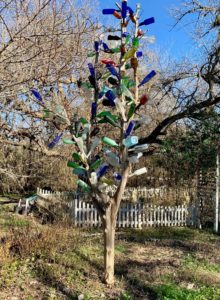Hello Fellow Readers,
 Happy 2019. I hope you all survived the fa la las and indulgences that can come with ringing in the new year. I’ll admit our recycle bin is overflowing with many trendy colors. We hosted Christmas Eve, so most of the bounty came from shared toasts; thank you very much. It makes me think of the bottle tree I saw while visiting Festival Hill in Round Top, Texas—an artful way to use recyclables, though it originated long ago. The sign explained, “One of the oddest superstitions from ancient folklore dates back to the glassblowers in ninth-century Africa. Several African tribes employed glass objects as talismans (magical objects) against evil spirits. Ever wonder why bottles moan in the wind?” Fascinating!
Happy 2019. I hope you all survived the fa la las and indulgences that can come with ringing in the new year. I’ll admit our recycle bin is overflowing with many trendy colors. We hosted Christmas Eve, so most of the bounty came from shared toasts; thank you very much. It makes me think of the bottle tree I saw while visiting Festival Hill in Round Top, Texas—an artful way to use recyclables, though it originated long ago. The sign explained, “One of the oddest superstitions from ancient folklore dates back to the glassblowers in ninth-century Africa. Several African tribes employed glass objects as talismans (magical objects) against evil spirits. Ever wonder why bottles moan in the wind?” Fascinating!
With further research, I learned they believed evil spirits find their way into inverted glass bottles and become trapped. Then come morning, as sunbeams hit the bottles, the evil spirits will be destroyed. It sounds like a long-ago cure for the evil spirit of a hangover.
Bottle trees were initially popular primarily in the south, most often in Crape Myrtles trees prevalent there; trees that have died, that is. Now they’ve grown to become an admired garden sculpture — colorful assortments of mostly wine bottles inverted on a wrought iron-looking post with arms like branches. Blue bottles are the desired dominant color, as blue is often associated with ghosts and spirits. Blue also is said to encourage healing. Perhaps that’s what the Milk of Magnesia manufacturers had in mind. So, after you settle your overindulged holiday tummy, your Phillips Milk of Magnesia will make a nice-looking bottle you can add to your tree.
At Festival Hill, they also used bottles stuck upside down in the soil as a garden edge with a cluster of spoons as a wind chime. Some would call it Shabby Chic. But around here, it may look like the camouflage of a bad habit –about that New Year’s resolution….
Garden Dilemmas? AskMaryStone@gmail.com and your favorite Podcast App
Enjoy the companion podcast:
Column updated 12/27/22





Thanks for this article confirming the origins of this traditional garden art form. I Have been enjoying “binge” reading your posts. today.
You are so welcome, Cynthia. I appreciate your “binge reading” my column. It brings a big smile. You can subscribe (for free) to get an email alert of news posts each week if you’d like. Thank you so much, Mary